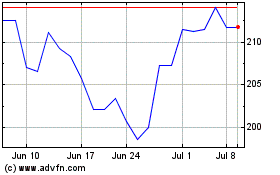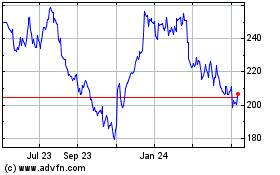Peer-Reviewed Published Study Shows Advantages
of Chlorhexidine/Silver Sulfadiazine-Impregnated CVC vs. Uncoated
CVC
Teleflex Incorporated (NYSE: TFX), a leading global provider of
medical devices for critical care and surgery, has announced that
newly published research has reaffirmed that the ARROW Central
Venous Catheter (CVC) with ARROWg+ard Blue PLUS® Technology reduces
the incidence of catheter-related bloodstream infections (CRBSIs)
and reduces direct costs related to treatment of these potentially
deadly infections.1
The prospective study, by Leonardo Lorente M.D., Ph.D. and
colleagues, independent from Teleflex, compared an unprotected CVC
to an antimicrobial protected CVC with ARROWg+ard Blue PLUS®
Technology. ARROWg+ard Blue PLUS® Technology protects the catheter
surfaces both intra- and extraluminally with chlorhexidine/silver
sulfadiazine. Authors tested the CVCs to determine which was more
cost effective, including the cost of treating any associated
infections.
The peer-reviewed paper appears as a featured article in the
March 2014 issue of the American Journal of Infection Control,
which is published by APIC, the Association for Professionals in
Infection Control and Epidemiology. Dr. Lorente works in the
Department of Critical Care at Hospital Universitario de Canarias,
in Tenerife, Spain.
The Lorente paper said the authors undertook the study because
previous cost-effectiveness analyses of antimicrobial catheters
included the cost of extended hospital stays. This cost varies
widely from institution to institution, limiting the
transferability of the results from institution to institution,
they said.
For this new study, the authors included only the costs of CVCs,
infection diagnosis, and antimicrobials used to treat patients who
suffered infections. These direct expenses, they believed, gave a
clearer picture of the ultimate cost-effectiveness of protected
catheters, given those catheters’ somewhat higher initial cost.
“Our research shows that this antimicrobial catheter is
cost-beneficial in jugular venous access. We believe that this
catheter could be cost-beneficial especially when used at insertion
sites that are associated with higher infection rates, such as
jugular vein with tracheostomy or femoral vein, or with patients
who have a higher risk of infection, such as immunocompromised
patients,” said Dr. Lorente.
The study involved patients admitted to the ICU of the Hospital
Universitario de Canarias in Tenerife, Spain, who received one or
more internal jugular venous catheters. It examined a total of 636
catheters and 3,271 catheter days. Each patient’s physician made
the decision about whether to use a protected or unprotected
catheter.
During the study, the ARROWg+ard Blue PLUS® CVC achieved zero
infections. In contrast to the zero infections associated with
ARROWg+ard Blue PLUS® CVCs, the unprotected catheters were
associated with infections in 2% of cases and a CRBSI rate of
5.04/1,000 catheter days. The antimicrobial catheter was also
associated with more prolonged CRBSI-free time than the unprotected
catheter.
The cost per catheter day of the protected catheter was roughly
half that of the unprotected catheter (€3.78 ± €4.45 vs. €7.28 ±
€16.71). The differences in CRBSI rate, cost, and catheter-free
time, as reported in this study, are statistically significant. The
cost was calculated in euros because the study was done in Spain.
As of the press release, the conversions to dollars would be ($5.22
± $6.14 vs. $10.05 ± $23.06).
“The statistically significant finding that the ARROWg+ard Blue
PLUS® CVC was the most cost-effective option is very important,”
said Jay White, President Vascular Access Division. “It shows the
value of looking not just at the initial cost of an infection
prevention device, but also considering its ability to improve
patient care and save hospitals money.”
As the authors pointed out, numerous government agencies and
professional societies have recommended protected catheters in
their guidelines for the prevention of CRBSIs. Among these
organizations are the CDC, Infusion Nurses Society (INS),
Infectious Diseases Society of America (IDSA) and Society for
Healthcare Epidemiology of America (SHEA).
“This impressive study demonstrates both the clinical efficacy
and cost-effectiveness of chlorhexidine/silver sulfadiazine
catheters,” said Keith Kaye, M.D., a US based infection prevention
expert who was not involved in the study. “The science behind the
antimicrobial coating and protection of internal and external
surfaces is well established, and this study adds to the large body
of clinical evidence showing the effectiveness of the device. There
is a reason it is the most widely used catheter of its type.”
“This study defined cost-effectiveness in very direct terms, but
hospitals should also consider the broader financial implications
of reducing CRBSIs,” said Kaye. “Patients are learning how to find
the safest hospitals, and they now have multiple places to look,
from hospital quality ratings by the Leapfrog Group and the Joint
Commission, to statistical leaders in states that require hospitals
to report healthcare-acquired infections. CRBSIs are weighted very
heavily in all of these rankings.”
Dr. Kaye is a professor of medicine at Wayne State University in
Detroit, Mich., and corporate director of Infection Prevention,
Hospital Epidemiology and Antimicrobial Stewardship at the Detroit
Medical Center. Dr. Kaye is a paid consultant of Teleflex.
More than 30 studies support the ability of ARROWg+ard
Technology to save lives and reduce costs by reducing infections.
Additional information may be found at www.arrowgard.com.
About Teleflex Incorporated
Teleflex is a leading global provider of specialty medical
devices for a range of procedures in critical care and surgery. Our
mission is to provide solutions that enable healthcare providers to
improve outcomes and enhance patient and provider safety.
Headquartered in Wayne, PA, Teleflex employs approximately 11,400
people worldwide and serves healthcare providers in more than 150
countries. Additional information about Teleflex can be obtained
from the company's website at teleflex.com.
Forward-Looking Statements
Any statements contained in this press release that do not
describe historical facts may constitute forward-looking
statements. Any forward-looking statements contained herein are
based on our management's current beliefs and expectations, but are
subject to a number of risks, uncertainties and changes in
circumstances, which may cause actual results or company actions to
differ materially from what is expressed or implied by these
statements. These risks and uncertainties are identified and
described in more detail in our filings with the Securities and
Exchange Commission, including our Annual Report on Form 10-K.
Teleflex, Arrow, and Arrowg+ard Blue PLUS are trademarks or
registered trademarks of Teleflex Incorporated or its affiliates©
2014 Teleflex Incorporated. All rights reserved. 2014-2921
References:1. Lorente L, Lecuona M, Jiménez A, et al.
Chlorhexidine-silver sulfadiazine-impregnated venous catheters save
costs. American Journal of Infection Control, 2014; 42:
321-324.
Teleflex IncorporatedJake ElguiczeTreasurer and Vice President,
Investor Relations610-948-2836
Teleflex (NYSE:TFX)
Historical Stock Chart
From Aug 2024 to Sep 2024

Teleflex (NYSE:TFX)
Historical Stock Chart
From Sep 2023 to Sep 2024
